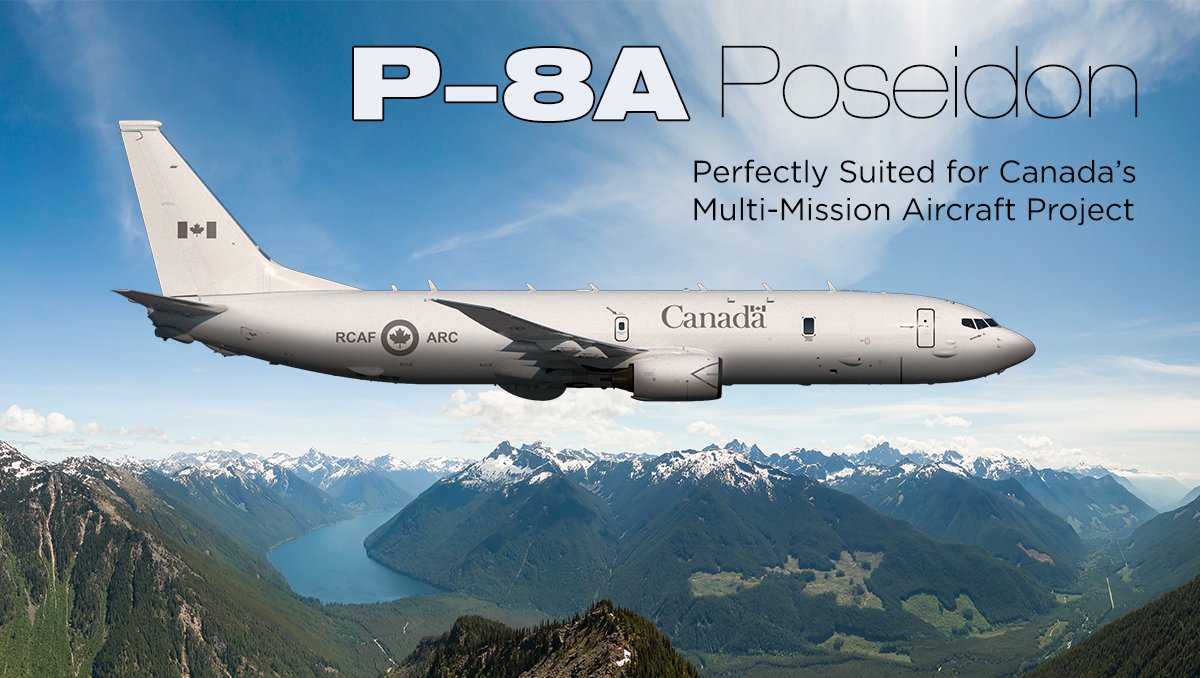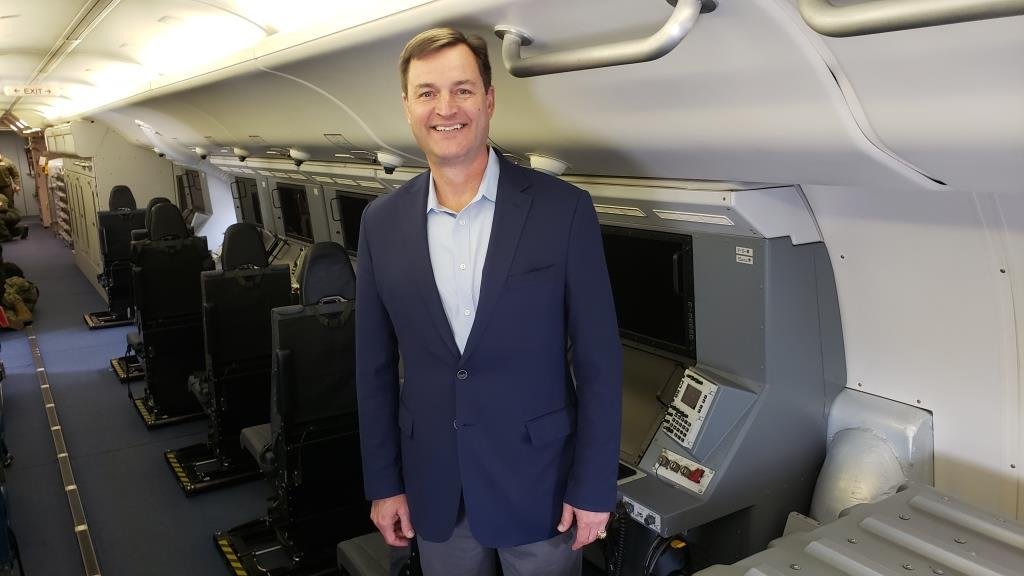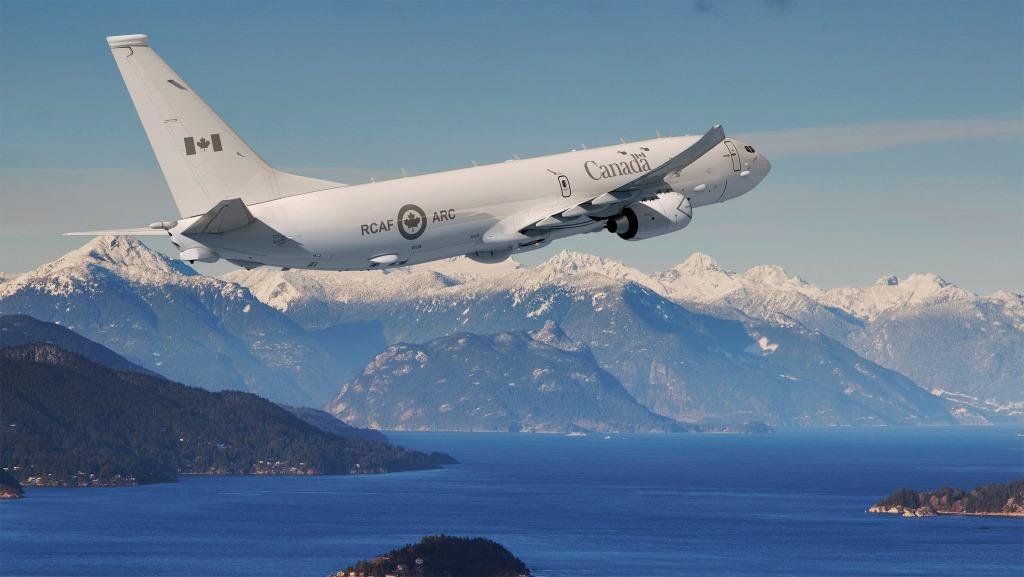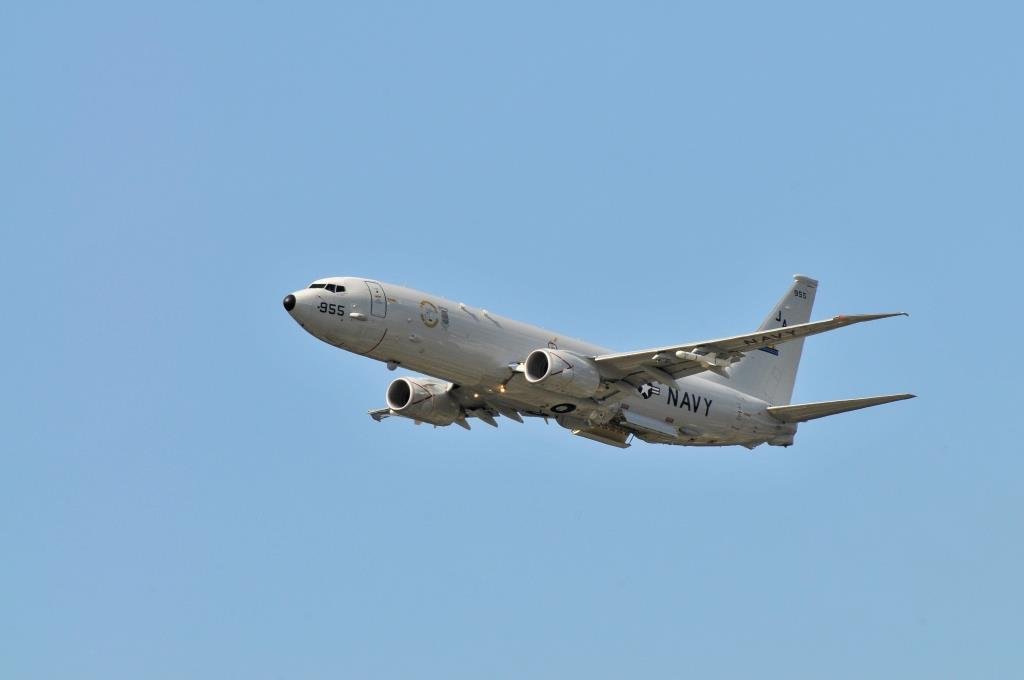COVER STORY - P-8 Poseidon: Perfectly Suited for Canada’s Defence and Foreign Affairs Strategies
BY JOETEY ATTARIWALA
P-8 Poseidon
Perfectly Suited for Canada’s Defence
and Foreign Affairs Strategies
The Government of Canada’s newly released Indo-Pacific strategy offers a remarkably frank assessment of the evolving security environment in calling out China’s “rapid and dramatic modernization of the People’s Liberation Army, including its offensive technological capabilities and geographic reach” and North Korea’s, “increasingly frequent and reckless testing of missiles.” These facts, coupled with the security and economic impacts of the Russian invasion of Ukraine in the Euro-Atlantic theater, portend a new urgency for Canadian defence and foreign affairs to adapt and respond.

The Canadian Government has defined a requirement to replace its aging fleet of CP-140 Aurora maritime patrol aircraft (a variant of the P-3 Orion) — which consists of 14 aircraft that have been in service since the early 1980s — with a newer multi-mission platform defined under the Canadian Multi-Mission Aircraft (CMMA) project.
In February 2022, Public Services and Procurement Canada (PSPC), on behalf of the Department of National Defence (DND), issued a Request for Information (RFI) which sought input from industry and other stakeholders on the High Level Mandatory Requirements (HLMR) and capability requirements pertaining to the replacement of the Aurora fleet, including industry’s interest, capability and experience to provide a long-range, long-endurance, multi-mission aircraft that meet these requirements.
The CMMA aircraft will be required by the Royal Canadian Air Force (RCAF) to provide the following minimum operational capabilities: Command, Control, Communications, Computers (C4), Intelligence, Surveillance and Reconnaissance (ISR) (C4ISR); Anti-Submarine Warfare (ASW); Anti-Surface Warfare (ASuW); Communications Relay; Network Extension; Overland Intelligence, Surveillance, Target Acquisition and Reconnaissance (ISTAR); and Search and Rescue (SAR).
Boeing’s solution for CMMA is the long-range P-8A Poseidon, a proven military off-the-shelf multi-mission maritime patrol aircraft which is arguably the most advanced and capable solution in the world today. The Poseidon offers advanced anti-submarine warfare, anti-surface warfare, intelligence, surveillance and reconnaissance, and search and rescue capability, and is the only non-developmental, in-service, in-production multi-mission aircraft that meets all CMMA requirements.
Boeing currently has an order book of 183 P-8 aircraft, and has produced and/or delivered 155 aircraft as of the writing of this article. Six nations currently operate the P-8, with South Korea soon to receive its first aircraft; and Germany being the most recent nation to select the P-8.
A NEW GENERATION OF MARITIME PATROL AIRCRAFT

In 2000 the United States Navy initiated its Multi-mission Maritime Aircraft program which sought to replace its fleet of turboprop P-3 Orion maritime patrol aircraft with a new and more capable platform. After a competitive process, The Boeing Company was awarded a contract in 2004 to develop its P-8 Poseidon solution, after which the first flight occurred in April 2009.
To develop the P-8 and achieve initial operational capability, Boeing along with the United States Navy, spent 9 years and over $7 billion USD to convert the 737-800NG (Next-Generation) aircraft into the P-8A Poseidon aircraft which exists today. This means that every subsequent customer reaps the benefits of that massive investment in non-recurring engineering. This fact cannot be understated as the cost of converting another aircraft into a military derivative which could satisfy CMMA HLMR is technically daunting, costly, and would likely take a decade or more to come to fruition.
When it comes to the aforementioned HLMR, only a few existing modern platforms come anywhere close to matching the capabilities of the multi-mission P-8 Poseidon with its state-of-the-art radars, sensors and air-to-air refueling capability.
The P-8A incorporates an integrated sensor suite that includes radar, electro-optical, and electronic signal detection sensors to provide search, detection, location, tracking, and targeting capability against surface targets. An integrated acoustic sonobuoy launch and monitoring system provides search, detection, location, tracking, and targeting capability against submarines. Sensor systems also provide tactical situational awareness information for dissemination to fleet forces and ISR information for exploitation by the intelligence community.
Designed with growth from the outset, the P-8A will receive periodic future enhancements to keep pace with threats and evolving technologies. In fact, the first US Navy P-8A Increment 3 Block 2 aircraft, which is assigned to Air Test and Evaluation Squadron (VX) 20, is currently undergoing testing in the anechoic chamber at Naval Air Systems Command in Patuxent River, Maryland. This is the first large post-production modification to the P-8 bringing significant new ASW sensor capabilities and upgrades to mission system architectures on the platform.
“The P-8A Poseidon offers a unique opportunity for the Royal Canadian Air Force today in that all of the development costs have been paid by other P-8 customers,” said Sean Liedman, director of International Business Development for Mobility & Surveillance aircraft, Boeing Defense, Space & Security. “By its non-developmental nature, P-8 offers an affordable solution that could protect and defend Canada for future generations.”
CANADIAN CONTENT
The strength of Canada’s Aerospace sector is recognized in the Industrial and Technological Benefits Policy through Key Industrial Capabilities of Aerospace Systems and Components, Training and Simulation, Electro-Optical / Infrared (EO/IR) Systems, In-Service Support and Defence Systems Integration. As such, the RFI issued by Canada sought information on how industry might engage Canadian capabilities for the CMMA procurement.
In proposing the P-8 Poseidon as their solution for CMMA, Boeing leads Team Poseidon, a pan-Canadian industrial team consisting of CAE, GE Aviation Canada, IMP Aerospace & Defence, KF Aerospace, Honeywell Aerospace Canada, Raytheon Canada, and StandardAero.
Team Poseidon builds on 81 Canadian suppliers to the platform and to more than 550 Canadian suppliers across all provinces contributing to Boeing's annual $5.3 billion CAD in economic benefit to Canada, supporting more than 20,000 Canadian jobs.
“As a dedicated partner of Canadian industry for more than a century, Boeing is proud to bring together a world-class team of companies in support of our P-8 offering to Canada,” said Heidi Grant, President, Business Development, Boeing Defense, Space & Security and Government Services. “Together, we will bolster Canada’s aerospace and defence industry through a 100% Industrial and Technical Benefits commitment if awarded the CMMA contract.”
The 81 Canadian companies that are suppliers to the P-8, build commercial 737 NG parts and some supply parts which are unique to the P-8. In all, it results in over $10 million USD of Canadian content on every P-8 that has ever been built. That means that Canada has already received more than $1.5 billion in economic benefits.
ALLIED INTEROPERABILITY
According to the RFI, the CMMA capability must have the ability to conduct limited, unsupported operations for a short period. This includes being able to deploy at short notice with minimal logistics or tactical support.
The P-8 is fully capable of deploying in such a manner, because although it is built from the ground up as a military aircraft, it retains “86% commonality” with the ubiquitous 737 NG, as stated by Perry Yaw, Senior Manager, Business Development for Mobility and Surveillance at Boeing. This key fact enables high P-8 serviceability rates when compared to other Maritime Patrol Aircraft, and the ability to deploy with high assurance that parts and supplies for flight critical components are readily accessible around the globe.
The P-8 Poseidon is the only modern maritime patrol platform that is deployed across various NATO allies and all Five Eyes partners (with the exception of Canada), which means these operators benefit from interoperability and from a robust global supply chain and support network which is already established, and that makes operating the P-8 vastly more sensible than other solutions.
Australia was the first Five Eyes export nation, after which the United Kingdom and New Zealand formalized their acquisitions. These acquisitions have enabled the Five Eyes partners to train P-8 personnel with each other's services.
The Royal Air Force’s (RAF) Seedcorn program is a prime example — it saw RAF aircrew, maintainers, and technicians embedded within US Navy P-8 squadrons. This symbiotic relationship assisted the RAF with the introduction of the P-8 weapon system, and provided a core of experienced personnel to operate UK Poseidon aircraft and bring them to Initial Operational Capability relatively soon after delivery.
This interoperability is essential in modern multi-domain operations as allied nations often work in concert with one another. The North American Aerospace Defense Command (NORAD) partnership between the United States and Canada is a prime example where the respective militaries work together day-in and day-out. Whether in training exercises or on deployed operations, it is not uncommon for US Navy maritime patrol squadrons to hand off surface or subsurface contacts to RCAF maritime patrol squadrons, and vice versa. This process is complex due to differing platforms and their sensor and communications systems, however sharing information would be vastly improved if all Five Eyes partners field the P-8.
“If you show up with a P-8 in peacetime, you are automatically interoperable and frankly interchangeable and can leverage your allies’ tools, support equipment, and supply chains,” Liedman told CDR. “And if you think about a wartime context where an adversary is trying to deny your supply chains, you can't just count on your own national supply chains being sufficiently protected in order to sustain your deployed operations. So therein lies the benefit of P-8 interchangeability for Canada.”
VERSATILITY & DEPLOYABILITY
The CMMA capability must also be able to perform a variety of different missions and roles consecutively and/or concurrently within the same aircraft configuration, to allow for in-flight re-tasking. For example, the CMMA could conduct an ASuW mission, followed by an ASW mission or joint fires support ashore, and then be re-tasked into a SAR mission to deploy survival equipment to assist locating survivors prior to returning to its main operating base — all while performing C4ISR functions throughout the flight. For all these requirements, the P-8’s standard configuration has the sensors and communications suite to carry out all tasks without reconfiguration, and always retains the capacity to carry weapons.
Some missions may however require specific capabilities that could lead to variations in that configuration, for example, special operations. For instances like this, Boeing offers a novel solution with its internally funded Multi-Mission Pod (MMP) for the P-8. Designed to be carried on the belly of the P-8, the MMP is perfectly suited to house plug-and-play sensors and systems. This exquisite capability enables operators to add capability without having to permanently modify and certify an aircraft.
“It’s a roll-on roll-off capability which you can upload or download at the squadron level without the need for special technicians,” said Liedman. “It’s a true force multiplier. Think of the ISTAR capability — if you build an airplane with an integrated sensor suite, then it’s unavailable any time the aircraft is in maintenance. If you have a roll-on roll-off solution like the Multi-Mission Pod, it increases the operational availability of the capability because it doesn't need to spend needless time in the depot when the host airframe is undergoing maintenance because you would just roll it to another airplane.”
COVERAGE FOR CANADA & BEYOND
The CMMA is expected to have the ability to conduct multiple 24/7 operations at the edges of Canada’s Areas of Responsibility (AOR) simultaneously from a Main Operating Base or Forward Operating Location with sufficient responsiveness to reach the edge of the AOR within four hours, and with sufficient un-refueled endurance for each sortie to remain on-station for at least four hours, and to return to base. The most restrictive range to be considered for this requirement is 1,178 nautical miles (the distance between CFB Comox to the Western edge of Canada’s domestic AOR). In addition, the CMMA must be capable of slower on-station speeds to conduct four hours of operation, which includes the continuous tracking of surface and subsurface contacts.
Again, the P-8 is suited to that requirement, as acknowledged by The Office of the Director, Operational Test and Evaluation in the United States: P-8A aircraft flight performance meets or exceeds operational requirements and fully supports execution of the ASW, ASuW, and ISR concept of operations. The aircraft can effectively self-deploy from main operating base locations to primary theater deployment sites and sustain long-term operations at more remote forward operating locations. Unrefueled range exceeds 4,000 nautical miles and increased transit speeds results in decreased response times and longer on-station times as compared to the legacy P-3C (of which the CP-140 Aurora is a variant).
WEAPONS CAPABILITIES
According to the Government, the CMMA capability must be capable of detecting, targeting, engaging and destroying specific threats. To achieve this, the CMMA must be capable of carrying and employing an appropriate combination of tailored kinetic and non-kinetic weapons and effects, both surface and non-surface. It will also be able to precisely deliver those weapons in adverse weather conditions, day and night, in permissive and non-permissive environments, and either overland or overwater (surface and subsurface).
The current weapons fit for the P-8 is the MK 54 torpedo, the AGM-84 Harpoon anti-ship cruise missile, and various sea mines, however there are significant new weapons capabilities coming to the P-8 in addition to its existing capacity to enable manned-unmanned teaming.
NAVAIR recently awarded Boeing a contract to integrate the Long Range Anti-Ship Missile (LRASM) to the P-8A. LRASM dramatically increases the anti-ship striking range of the P-8A. In addition, the US Navy’s High Altitude Anti-Submarine Warfare Weapon Capability (HAAWC) has achieved initial operational capability. HAAWC is a new technique of delivering the MK 54 torpedo from a P-8 at higher altitudes and longer ranges than conventional low-altitude employment. This solution sees the MK 54 mated to an Air Launch Accessory (ALA) wing kit. In this configuration, the ALA glides the MK 54 down to an acceptable altitude and then releases the torpedo to an intended entry point as assigned by the P-8 combat system.
OPTIMIZED FOR CANADA
As one can see, the P-8 is well suited to fulfill all the HLMR of the CMMA project which is defined in Canada’s Defence Policy, Strong, Secure, Engaged. In addition, Canada’s new Indo-Pacific Strategy presents a comprehensive road map to deepen Canada’s engagement in the Indo-Pacific over the next decade and is meant to increase contributions to regional peace and security. The Strategy states that as great power competition deepens in the region, inter-state tensions are also on the rise, all of which threaten regional peace and prosperity. This of course is of great importance to Canada as the Indo-Pacific region includes major trading partners, so regional stability and adherence to the international rule of law is of paramount importance. Maritime patrol aircraft like the P-8 are instrumental in providing ISR and maintaining/protecting sea lanes of commerce and communication.
The Indo-Pacific Strategy outlines five interconnected strategic objectives and states that Canada will invest in an enhanced military presence, along with intelligence and cyber security, to promote security in the region and ensure the safety of Canadians. In all these instances, the P-8 Poseidon, with its long-range, advanced sensors and weapons capability is perfectly suited to enable Canada’s strategies for defence and foreign affairs.
Joetey Attariwala is CDR’s Aviation Editor


